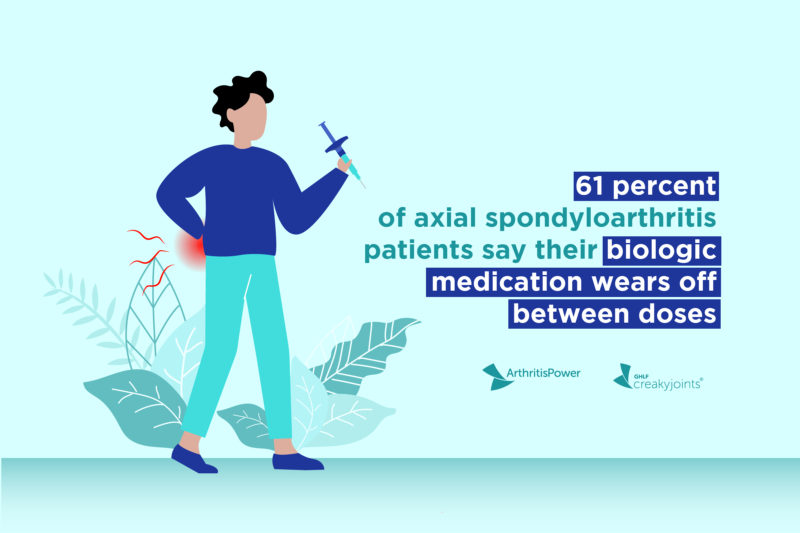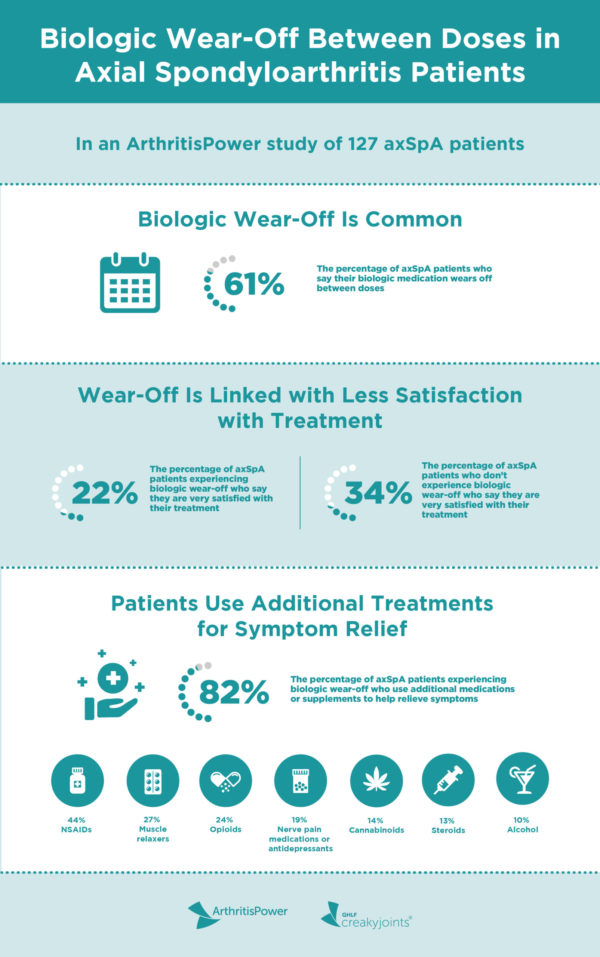If you overdo it at the gym or lift heavy boxes while moving, you may experience some back pain as a result. This is known as mechanical back pain, which occurs when there’s a disruption in the way the components of the back (the spine, muscle, intervertebral discs, and nerves) fit together and move, according to the National Institute of Neurological Disorders and Stroke. If you take some ibuprofen, ice the painful area, and avoid strenuous activity, the pain will subside.
Unfortunately, treating axial spondyloarthritis (axSpA) is not as simple. Axial spondyloarthritis is a type of inflammatory arthritis. The back pain and other symptoms it causes result from your immune system mistakenly attacking your joints.
Non-steroidal anti-inflammatory drugs (NSAIDs) are often a first-line treatment for axSpA. This is a natural (and, in some cases, unintentional) first step, especially for patients who have yet to be diagnosed and may be mistaking inflammatory pain for mechanical pain. If NSAIDs don’t sufficiently relieve symptoms, then a health care provider will likely suggest starting a biologic disease-modifying antirheumatic drug, or biologic DMARD. This type of medication targets part of the immune system to reduce inflammation and treat axSpA symptoms.
Over the years, researchers have found biologics to be an effective treatment for axSpA. But how do axSpA patients taking the biologics — the people who deal with pain, stiffness, and limited mobility regularly — feel about their effectiveness, especially when it comes to treatment wearing off between doses of medication?
Biologics are administered as injections or infusions. They may be given weekly, every other week, monthly, or even less often, depending on the specific medication. The medication should effectively relieve pain and symptoms until the next dose, but that is not always the case. Some patients report feeling an uptick in symptoms as they get closer to their next dose, which suggests they may be living with pain and may require additional treatment to help.
A new study from Global Health Living Foundation (GHLF) and CreakyJoints sought to gain insight into the experience and perspective of axSpA patients who use biologic treatment with a focus on the impact of treatment wear-off between doses. Initial findings from the study were presented during the European E-Congress of Rheumatology 2021.
Axial spondyloarthritis patients from our ArthitisPower research registry completed a survey about their treatment experience, which included questions about biologic satisfaction and use of additional medications or supplements. They also completed various patient-reported outcome (PRO) measures, including the Bath Ankylosing Spondylitis Disease Activity Index (BASDAI), PROMIS Pain Interference, PROMIS Physical Function, and PROMIS sleep disturbance.
PROs are a very important tool for measuring and monitoring disease in arthritis patients. Unlike a doctor’s evaluation, PROs are a patient’s own assessments of how their condition affects their symptoms, daily tasks, and quality of life — including how they rank or define the difficulty of simple activities like getting into a car or buttoning a shirt.
The patients included in the survey were mostly female (83 percent) and white (90 percent), so the results may not be generalizable to all patients with axSpA. The average age was 47.
Here is what we learned.
Overall, axial spondyloarthritis patients are satisfied with their biologic treatment
Of the 128 patients surveyed, 27 percent said they were very satisfied with their biologic therapy, while 58 percent said they were somewhat satisfied. Additionally, 53 percent of patients said they were specifically satisfied with how well their current biologic treatment controlled axSpA-related pain.
For the few patients — 15 percent — who said they were not satisfied with their biologic treatment, side effects and worry about side effects were the most common reasons.
Treatment wear-off impacts overall satisfaction with biologics and is associated with worse symptoms
Many axSpA patients surveyed — 61 percent — said their biologic wears off between doses. About 15 percent of patients said their biologic does not wear off before the next dose; about 24 percent reported being unsure of whether or not it wears off.
Perhaps not surprisingly, wear-off was reported more often among people who were somewhat satisfied or dissatisfied with their overall treatment.
Of the patients who reported wear-off:
- 22% were very satisfied with their treatment
- 60% were somewhat satisfied with their treatment
- 18% were dissatisfied with their treatment
Of the patients who reported no wear-off:
- 34% were very satisfied with their treatment
- 54% were somewhat satisfied with their treatment
- 12% were dissatisfied with their treatment
In addition to comparing overall satisfaction rates between the wear-off and no wear-off patients, researchers also compared the PRO results of the two groups. (This was to understand how symptoms might be associated with biologic wear-off.) Researchers found that patients who reported biologic wear-off had significantly worse self-reported axSpA disease activity and sleep disturbance scores than patients who did not report wear-off. (Patients who reported biologic wear-off also had worse self-reported pain scores, but they were not significantly worse than those of the other group of patients.)
Many axSpA patients who experience biologic wear-off use other treatment to manage symptoms between doses.
Among the patients who reported biologic wear-off, 82 percent said they use additional medications or supplements to help relieve symptoms. These patients were asked to select all additional treatments they use:
- 44% use NSAIDs (ibuprofen, naproxen, celecoxib, meloxicam, etc.)
- 27% use muscle relaxers (carisoprodol, chlorzoxazone, cyclobenzaprine, etc.)
- 24% use opioids (oxycodone, hydrocodone, codeine, etc.)
- 19% use nerve pain medications or antidepressants (gabapentin, pregabalin, or duloxetine)
- 14% use cannabinoids
- 13% use steroids
- 10% use alcohol
- 5% use an unlisted medication or supplement
Improvements in biologic treatment duration and conversations about biologic efficiency are needed to improve axSpA patient care
A recent proliferation in biologic therapies for axial spondyloarthitis continues to have a dramatic impact on patient care. But this research suggests that it’s important to learn more about how the duration of treatment effectiveness between doses affects patients’ symptoms and quality of life.
“It seems like axSpA patients are looking for more from their treatment,” says study author W. Benjamin Nowell, PhD, Director of Patient-Centered Research at the Global Healthy Living Foundation. “Though patients are generally satisfied, sometimes the biologics will wear off between doses, so they have to find other ways to cope or manage until their next dose. We need to be asking how we can do better in managing axSpA; how can we either find new treatments or better combinations of treatments.”
Part of doing better is improving communication between patients and their health care providers when it comes to biologic treatment wear-off.
“It would help if providers let patients know that their biologic may wear off between doses and give them guidance about what they can do if their dose does wear off and they have residual pain,” Nowell says. “Setting expectations is important, as is partnering with your doctor to make sure you’re aware of and safely using additional therapies if necessary.”
If biologic treatment wear-off is a problem for you, talk to your doctor to find effective solutions. You may need a medication that is given more frequently, for example, or find additional ways to manage pain when you’re approaching your next dose.
This study did not ask about additional non-pharmacologic therapies, such as physical therapy and exercise, stress reduction, and meditation. But it may be the case that utilizing additional lifestyle-focused treatments may further help patients cope with breakthrough symptoms due to wear-off between biologic doses.
Track Your Medications with ArthritisPower
Join CreakyJoints’ patient-centered research registry and log your medications to track side effects and impact on disease activity. Learn more and sign up here.
This study was supported by Eli Lilly, which is a corporate sponsor of the Global Healthy Living Foundation.
Interview with W. Benjamin Nowell, PhD, Director of Patient-Centered Research at the Global Healthy Living Foundation
Nowell WB, et al. Patient perspectives of biologic treatments for axial spondyloarthritis: satisfaction, wear-off between doses, and use of supplemental medications. Annals of the Rheumatic Diseases. Volume 80, Supplement 1. 2021.







